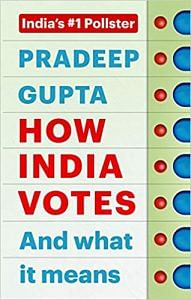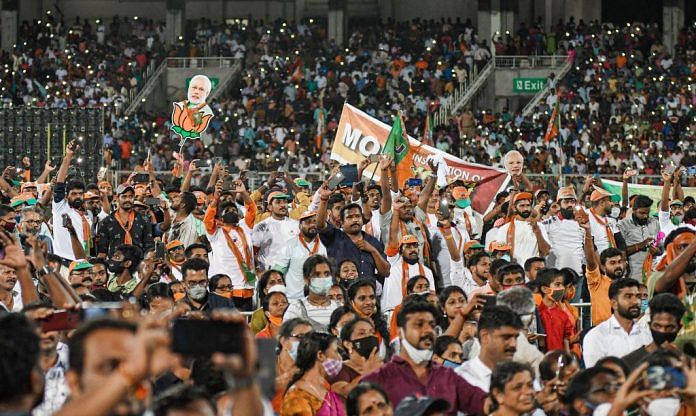Ahead of the 2014 parliamentary polls when debutant prime ministerial candidate Narendra Modi held whirlwind tours and addressed massive gatherings across states, his audiences scaled buildings, walls and hoardings to get a glimpse of the rising national star. They listened to him with rapt attention, cheering out of turn, breaking into rapturous applause at his sharp jibes against the incumbent United Progressive Alliance government. The crowds just went wild with Modi’s appearance on the podium. Did that reflect his influence over the people? Most certainly. Did that mean the BJP would win? Well, maybe. Did that mean all the candidates he was campaigning for in each of those rallies would win comfortably? Not really.
Rallies are all about fun, festivity and funds and have little or almost no impact on the voting choices of people. A massive, bustling public meeting is not indicative of a candidate’s bright prospects. It merely means that the local organization of the party is robust or that the party/candidate has adequate funds to mobilize the local electorate to show up for a few hours in their support. The rally’s strength or success has no bearing whatsoever on how those same voters will vote. Because the choices are not dependent on what they hear at the rally but on what has been driven home through the campaign and of course on other factors like a promising leader at the helm of the party, connect with the local leadership, caste or community equations and the like.
Back in the early years after Independence, people were keen to listen to their leaders but hardly had the opportunity. Speeches by the prime minister or president trickled in on the radio on special occasions like Independence Day and Republic Day or in case of an emergency. There was no way of seeing or listening to them up close like we do in the age of social media. But because the communication was so restricted and the platforms so limited, leaders as well as voters took public rallies far more seriously. Leaders were careful about what they projected before the audience. They weighed their words, knowing they would be held accountable for their statements. It was also their primary image-building exercise and hence they were cautious not to make irresponsible statements, unlike leaders today who have the luxury of explaining their bloopers during speeches at rallies and public meetings by tweeting or posting on Facebook or issuing a press statement.
Rallies have also lost their appeal as the communication gap between the voter and the candidate stands bridged today. Voters get to interact directly with their leaders on Twitter and Facebook and through live interactive videos across platforms. Technology has enabled the voter to reach out directly to the topmost leaders in the country, who have learned to use social media platforms to their advantage. While young and old alike use smartphones today and are connected with the larger community through popular platforms like WhatsApp, Facebook and YouTube, in several households where the elderly are not familiar with technology, they depend on second-hand information from the youth in the family. The youth influence decision-making by relaying trends and moods they pick up through social media.
Also read: Modi, Shah, Mamata or Rahul, no one cares about EC Covid warning & rallies continue as usual
Every time the prime minister follows someone on Twitter, he also manages to reach out to that entire community, region or profession. It appears as though he has a direct connect with the masses and this portrays him as a people’s person. Social media has effectively rendered public rallies redundant because the leaders have several other channels of communication that are more personal and intimate. The impersonal nature of public rallies does not help in creating any connect with the masses.
Moreover, not all rallies can be held on a Sunday or a holiday and elections are scheduled such that they do not happen around festivals. On working days it is next to impossible to get people in the metros to skip work and turn up for a rally during the day.They are held in the evenings, by when people are tired after a hard day’s work, especially with all the big city commute. Even in smaller towns, it is very difficult to mobilize voters on a working day. In the summers, crowds get restless during the long wait ahead of a leader’s arrival at the rally and the organizers are only too eager to tell you about the anxiety they go through while holding the people back. Yet politicians love their moment in front of a massive gathering. Rallies also help political parties amplify their campaigns, especially those around tall leaders like the prime minister, chief ministers or popular national leaders. It gives them good publicity, value for money I would say, as news channels are keen to livecast speeches from rallies of key leaders like Narendra Modi, Rahul Gandhi, Mamata Banerjee, Mayawati and Arvind Kejriwal. Even amid the nationwide lockdown due to Covid-19, rallies continued to be held through the Bihar assembly polls and ahead of the West Bengal polls, violating all physical distancing guidelines.
Also read: Why BJP just can’t digest the election defeat to Mamata in West Bengal
Earlier people endured all the discomfort in the hope they would get to hear their leader directly but now as politicians speak at multiple platforms there is no novelty left in a speech at a rally. Speeches at rallies, much like manifestos, are taken with a pinch of salt. Voters are jaded by now, thanks to all the years of false promises by our politicians. The release of a manifesto has become a mere formality and in some elections they are made public barely a few days before polling. In the 2014 parliamentary polls, the BJP released its manifesto in the north-eastern states after the first phase of polling. So, well, that is how much we value that document.
However, rallies are undeniably great fun, almost like the annual village fair, as long as it is not the parliamentary elections, which are held in peak summer. Free rides to the venue, food packets and a token amount, however, make the effort worth it, not to mention the picnic that it finally turns out to be! My guesstimate is not even 10 per cent of the crowd that claps and cheers for the leader in question will vote for him/her on the basis of what they hear at the rally. On several occasions, political leaders tell me, ‘Oh, I held such a big rally but your poll says something else . . . you must have got it wrong. If so many connected with us, how can they not vote for us!’ I have a standard reply to this. Let the results speak. I have, in most cases, had the last laugh.
 This excerpt from ‘How India Votes’ by Pradeep Gupta has been published with permission from Juggernaut Books.
This excerpt from ‘How India Votes’ by Pradeep Gupta has been published with permission from Juggernaut Books.



